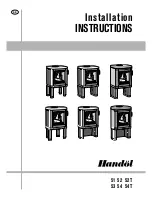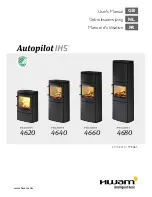
If an existing chimney is to be used it must be swept and checked, it
must be in good condition, free from cracks and blockages, and
should not have an excessive cross sectional area. If it was previously
used by an open fire then the chimney should be swept one month
after installation to clear any soot falls which may have occurred due
to the difference in combustion between the stove and the open fire.
If you find that the chimney is in poor condition then expert advice
should be sought
regarding the necessity of having the chimney lined.
If it is found
necessary to line the chimney then a lining suitable for
Solid Fuel must be used.
If there is no existing chimney then a prefabricated block chimney or
a twin walled insulated stainless steel flue to BSEN 15287-1:2007 can
be used either internally or externally. These chimneys must be fitted
in accordance with the manufacturers instructions and Building
Regulations.
Single wall flue pipe is suitable for connecting the stove to the
chimney but is not suitable for using for the complete chimney. If it is
found that there is excessive draw in the chimney then a draught
stabiliser should be fitted.
It is important that there is sufficient draw in the chimney and that
the chimney does not suffer from down-draught. When the chimney
is warm the draw should be not less than 1.25mm (0.05") water
gauge (12 Pa). If in doubt about the chimney seek expert advice.
HEARTH AND FIRE SURROUND
The stove must stand on a fireproof hearth and must not be situated
closer than the minimum distance from combustible materials (see
specification table) to the sides or rear above hearth level unless
adequately fireproofed in accordance with local building regulations.
The hearth must be of fireproof material and at least 12mm (1/2in.)
thick. The positioning of the stove and the size of the hearth are
governed by building regulations for Class 1 appliances. These
building regulations state that the hearth must extend in front of the
stove by at least 225mm (9 in.) and to the sides of the stove by at
least 150mm (6 in.). When the fire door is open, it extends beyond
the flat front of the stove by 430mm - Skye 5.
If in doubt as to the positioning of the stove, expert advice should be
sought either from the supplier or the local building inspector. The
fireplace must allow good circulation of air around the appliance to
ensure that maximum heat is transferred to the room and also to
prevent the fireplace from overheating. A gap of 150mm (6") each
side and 300mm (12") above the appliance should give sufficient air
circulation. If a wooden mantelpiece or beam is used in the fireplace it
should be a minimum of 460mm (18"), and preferably 600mm (24")
from the appliance. In some situations it may be necessary to shield
the beam or mantelpiece to protect it.
In order for the fire to operate correctly and to allow for access,
there must be an air gap behind the appliance of at least 50mm, but
be aware that this distance will need to be greater in some cases to
meet Building Regulation requirements.
The appliance should be installed on a floor with adequate load-
bearing capacity. If an existing construction does not meet this
requirement then please take suitable measures to achieve this. (e.g.
11
®
INSTALLATION INSTRUCTIONS
Alternative
Soot Door
Positions
Register Plate
With Soot Door
Register Plate
Soot Door
in side or rear
of Chimney
Fig.7. Vertical register plate with bricked up fireplace
Fig.8. Horizontal register plate with rear flue connection
Содержание Skye 5
Страница 1: ...Operating Installation Instructions ...
Страница 2: ......
Страница 18: ......
Страница 19: ......






































